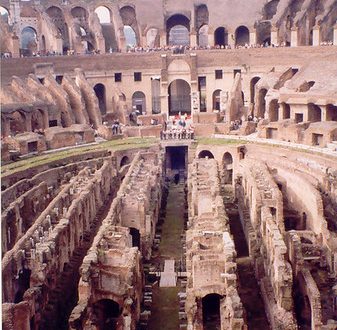 Two British film-makers have discovered what they believe to be the source of the 1,900-year old aqueduct built by the emperor Trajan in the early second century AD.
Two British film-makers have discovered what they believe to be the source of the 1,900-year old aqueduct built by the emperor Trajan in the early second century AD.
The underground chambers were found and filmed after some years of research into Roman hydraulics by the documentary-makers Ted O’Neill and his father Michael O’Neill.
According to Ted, it took some perseverance to find the location, which was hidden beneath a disused church some 30-40km north-west of Rome. Despite difficulties and delays in getting access to the site, the O’Neills were finally able to enter the underground chambers of the church in June 2009.
While the aqueduct was used from Roman times until the ninth or tenth centuries, by the Renaissance period it had fallen out of use. It was rebuilt by Pope Paul V between 1605 and 1615 and renamed the Aqua Paola after him. It still carries spring water to Rome to this day (culminating at ‘Il Fontanone’ on the Janiculum Hill).
Aqua Traiana: Huge Importance to Ancient Rome
However, the source of the Aqua Traiana/Aqua Paola had fallen out of the public consciousness, despite the fact that it was known as recently as 1935. A reference to it in a book, The Aqueducts of Ancient Rome by Thomas Ashby, who was director of the British School at Rome between 1906 and 1925, helped lead the O’Neill team to the right spot near the ruined chapel of Santa Fiore, on the shores of Lake Martignano (near Lake Bracciano).
The Aqua Traiana transported pure spring water to the Janiculum Hill, providing bathing and drinking water for people in that area, water for industry, as well as water for the original St Peter’s church (built during the reign of Constantine I) from the fourth century onwards.
According to Mike O’Neill, this was of ‘enormous importance’ to ancient Rome. He adds: The site of the water source was also of great religious importance.
The source is right in ancient Etruria the area of northern Lazio and southern Tuscany today and was also an important water source for the Etruscans. The Romans, under emperor Trajan at the start of the second century AD, then built a nymphaeum at the site and built their aqueduct to take the water to Rome.
This enabled the Romans to bring about what could be seen as one of the first industrial revolutions, said Mike O’Neill. With a plentiful water supply coming into the city from the north, the Romans were able to expand certain industries such as grain grinding and stone sawing.
The water was also important as a domestic source. Trajan went to great lengths to collect very pure spring water, which enabled a big improvement in hygiene and sanitation, as well as drinking water. I don’t think it’s a coincidence that at the time, the empire was able to grow to its greatest extent, while the city of Rome also had a population of as many as 1.5 million.
According to Ted O’Neill, the moment the film-crew entered the underground chambers for the first time, they were struck by the preservation of the Roman opus reticulatum brickwork. They were accompanied by professor Lorenzo Quilici, an expert of ancient Roman topography from the University of Bologna.
Filming Inside the Underground Spring
 Ted O’Neill explained: The chapel has two rooms extending off to each side, both of which are bricked off. The base of the structure is semi-oval shaped. The chapel is about 3m below today’s ground level, so a ladder was needed to get down into a chamber behind a bricked-up arch, as well as lighting equipment.
Ted O’Neill explained: The chapel has two rooms extending off to each side, both of which are bricked off. The base of the structure is semi-oval shaped. The chapel is about 3m below today’s ground level, so a ladder was needed to get down into a chamber behind a bricked-up arch, as well as lighting equipment.
There, the team found beautiful brickwork in pristine condition. Professor Quilici confirmed that they are in fact Roman. Beyond this subterranean chamber, there is a long gallery that leads to the beginnings of Trajan’s aqueduct.
The team was researching and filming another Roman aqueduct at the time the Aqua Alsietina, which also begins at Lake Martignano. Ted O’Neill said: We’ve been very interested in aqueducts from the north of Rome although those that come into Rome from Tivoli and from the Castelli Romani are more commonly talked about.
The shores of both Lake Bracciano and Lake Martignano were known to the ancient Romans as a leisure retreat from the city. The Aqua Alsietina transported water into the Trastevere area of Rome (to Augustus’s ‘naumachia’ -a man-made lake where the Romans could re-enact sea battles).
The O’Neills run a small production company making documentaries and films. Film-makers by trade, their work has led them to some in-depth research into the aqueducts of Rome since they first became interested in the Aqua Vergine Nuova some time ago. They are interested in documenting these ancient structures from an historical viewpoint, as well as covering the Renaissance restorations and the modern state and use of the aqueducts.
As Mike says, Rome is the only city in Europe that uses aqueducts for its entire water supply, which is particularly interesting at a time when water supply is a serious problem in many parts of the world.
A conference giving more information on the source of the Acqua Traiana will be held this Thursday, 28 January at the Hotel Quirinale, via Nazionale, Rome. Contacts: Ted O’Neill (edward.oneill@gmail.com
0039-370-705-1538 – English and Italian) and Mike O’Neill (m.eon@btopenworld.com – English only).





